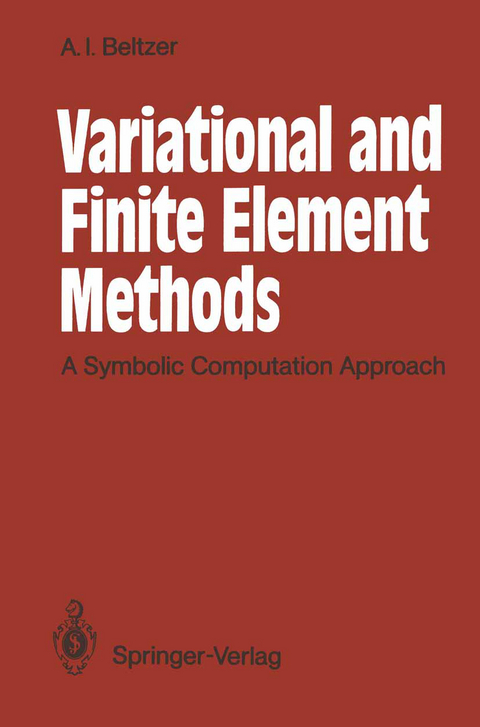
Variational and Finite Element Methods
Springer Berlin (Verlag)
978-3-642-83916-0 (ISBN)
I Symbolic Manipulation Codes.- 1.1 Notions of LISP and Expert Systems.- 1.2 First Sessions.- 1.3 Matrices.- 1.4 Solving Equations.- 1.5 Limits and Expansions.- 1.6 Integration.- 1.7 Some Useful Commands and Options. Pattern Matching.- 1.8 Conditionals, Iterations and Compound Statements.- 1.9 Few Hints.- 1.10 Example: Steady-State Linear Vibrations.- 1.11 Example: Transient Vibrations.- 1.12 Example: Free Nonlinear Vibrations.- 1.13 Example: Forced Nonlinear Vibrations.- II Variational Approach and Equations of Motion.- 2.1 Mechanics of a Particle.- 2.2 System of Particles. Generalized Coordinates.- 2.3 Functional and its Euler-Lagrange Equation.- 2.4 Hamilton's Principle for Discrete Systems.- 2.5 Constrained Motions.- 2.6 Virtual Work.- 2.7 D'Alembert's Principle. Nonconservative Systems.- 2.8 Transition to Continuous Systems.- 2.9 Hamilton's Principle for Continuous Systems, Part I.- 2.10 Hamilton's Principle for Continuous Systems, Part H.- 2.11 Minimum of Potential Energy. Imposed and Natural Boundary Conditions.- 2.12 Computer-generated Governing Equations.- 2.13 Single Degree of Freedom.- 2.14 Two Degrees of Freedom. Double Nonlinear Pendulum.- 2.15 Dynamic Shock Absorber.- 2.16 Continuous Systems.- 2.17 Automatic Generation, Part I.- 2.18 Automatic Generation, Part II.- 2.19 Second Variation and Nature of Extremum.- 2.20 Legendre's Condition.- 2.21 Transversality Conditions.- 2.22 Generalizations and Transformations of Variational Problems.- 2.23 Minimum Pressure Drag.- 2.24 Constrained Minimum Pressure Drag.- III Direct Methods.- 3.1 The Philosophy.- 3.2 The Method of Least Squares. Trial Functions.- 3.3 Beam on Elastic Foundation, Part I.- 3.4 Beam on Elastic Foundation, Part II.- 3.5 The Bubnov-Galerkin Method.- 3.6 Beam on Elastic Foundation,Part III.- 3.7 The Rayleigh-Ritz Method.- 3.8 Master Program.- 3.9 Applications.- 3.10 Improved Master Program.- 3.11 Considerations of Accuracy.- 3.12 Plate on Elastic Foundation.- 3.13 Further Investigations of Plates.- 3.14 Other Direct Methods.- 3.15 Shock Absorber, Preliminary Considerations.- 3.16 Shock Absorber, Program and Results.- 3.17 Flow Through a Duct.- 3.18 Temperature Field in a Plate, Part I.- 3.19 Temperature Field in a Plate, Part II.- 3.20 Free Vibrations by the Rayleigh-Ritz Method.- 3.21 Free Vibrations of a Non-uniform Beam.- 3.22 Master Programm.- 3.23 Free Vibrations by gthe Bubnov-Galerkin Method.- 3.24 Nonlinear Vibrations by the Bubnov-Galerkin Method.- 3.25 Mathematical Considerations. Scalar Products of Functions.- 3.26 Operators and Functionals.- 3.27 Symmetric and Positive Definite Operators.- 3.28 Minimum Theorem and Minimizing Sequence.- 3.29 Orthogonal and Linearly Independent Functions.- IV Introduction to the Finite Element Method.- 4.1 Finite Elements. The Element Stiffness Matrix.- 4.2 Energy Analysis of a Finite Element.- 4.3 Truss Element.- 4.4 Physical Meaning of the Element Matrices.- 4.5 Global Reference Systems.- 4.6 Generalizations. Governing Equations of a Structure.- 4.7 Assembling.- 4.8 Formalization of Assembling.- 4.9 Truss.- 4.10 Further Analysis of a Truss.- 4.11 Composite Beam.- 4.12 Particular Cases.- 4.13 Automatic Generation of the Assembly Stiffness Matrix.- 4.14 Optimization.- 4.15 Reduced Stiffness Matrix.- 4.16 Free Vibrations of Beams.- 4.17 Plate Element, Part I.- 4.18 Plate Element, Part II.- 4.19 Particular Cases. Batch Mode.- 4.20 Compatibility and Convergence.- 4.21 Natural Coordinate Systems.- 4.22 The Concept of Isoparametric Elements.- 4.23 Some Plane Elements.- 4.24 Concluding Remarks.- Problems.- Answers.- References.
| Erscheint lt. Verlag | 10.1.2012 |
|---|---|
| Zusatzinfo | XI, 256 p. |
| Verlagsort | Berlin |
| Sprache | englisch |
| Maße | 155 x 235 mm |
| Gewicht | 416 g |
| Themenwelt | Informatik ► Weitere Themen ► CAD-Programme |
| Mathematik / Informatik ► Mathematik ► Angewandte Mathematik | |
| Technik | |
| Schlagworte | Calculus • Expertensysteme • Finite-Elemente-Methode • Finite-Elemente-Methode (FEM) • Finite Element Method • Mechanics • Operator • Optimization • Transformation • Variationsdifferenzmethode • Vibration |
| ISBN-10 | 3-642-83916-9 / 3642839169 |
| ISBN-13 | 978-3-642-83916-0 / 9783642839160 |
| Zustand | Neuware |
| Haben Sie eine Frage zum Produkt? |
aus dem Bereich


